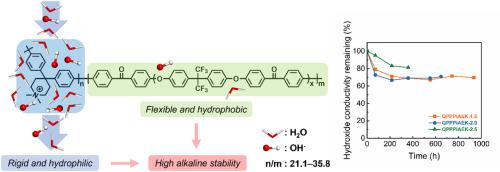Journal of Membrane Science ( IF 8.4 ) Pub Date : 2023-09-09 , DOI: 10.1016/j.memsci.2023.122057 Lei Qi , Xin Wang , Ge Chao , Nanwen Li , Xuan Zhang

|
In alkaline environments, the cationic groups and polymeric backbones of conventional poly(arylene ether ketone)-typed anion-exchange membranes (AEMs) tend to degrade. Herein, we report poly(phenylene piperidinium-co-arylene ether ketone)s (QPPPiAEK-x) with enhanced alkaline stability as potential AEM candidates. Specifically, a diphenyl piperidine precursor was synthesized and subjected to Ni(0)-catalyzed coupling polymerization with poly(arylene ether ketone) oligomers and followed by classic Menshutkin reaction. Membranes with an ion exchange capacity ranging from 1.85 to 2.24 meq g-1 showed high water uptakes (97.7%–159.2%) and high OH- conductivities at 80 °C (73.4–82.2 mS cm-1) but moderate swelling behaviors (i.e., in-plane swelling ratios of 28.0%–35.8%, and through-plane swelling ratios of 28.4%–56.2%). Morphological studies confirmed the presence of hydrophilic–hydrophobic microphase separation (ionic domain sizes of 17.9–22.3 nm) in all membranes, which was ascribed to the high feed content of phenylene piperidinium blocks. The H2/O2 single-cell test revealed the highest power output (187.7 mW cm-2) for the QPPPiAEK-2.0 membrane at 60 °C and 100% relative humidity. During the stability test, all membranes exhibited adequate ion conduction abilities. The most durable membrane retained 69.6% of its initial conductivity after 936 h in a 1 M NaOH solution at 80 °C. Results of ex-situ nuclear magnetic resonance spectroscopy revealed that approximately 9.7%–20.6% of cationic decomposition was the main degradation pathway for the QPPPiAEK-x ionomers, whereas 2.6%–4.4% accounted for the cleavage of backbones. Our study provides a promising methodology for fabricating alkali-stable AEMs for fuel cell applications.
中文翻译:

通过亚苯基哌啶嵌段增强聚亚芳基醚酮型阴离子交换膜的碱性稳定性
在碱性环境中,传统聚亚芳基醚酮型阴离子交换膜(AEM)的阳离子基团和聚合物主链容易降解。在此,我们报告了具有增强碱性稳定性的聚(亚苯基哌啶鎓-共-亚芳基醚酮)(QPPPiAEK-x)作为潜在的 AEM 候选者。具体来说,合成了二苯基哌啶前体,并与聚(亚芳基醚酮)低聚物进行 Ni(0) 催化的偶联聚合,然后进行经典的 Menshutkin 反应。离子交换容量范围为 1.85 至 2.24 meq g -1的膜在 80 °C 时表现出高吸水量 (97.7%–159.2%) 和高 OH -电导率 (73.4–82.2 mS cm -1)但溶胀行为中等(即面内溶胀率为28.0%–35.8%,面内溶胀率为28.4%–56.2%)。形态学研究证实所有膜中都存在亲水-疏水微相分离(离子域大小为 17.9-22.3 nm),这归因于亚苯基哌啶鎓块的高进料含量。H 2 /O 2单电池测试表明,QPPPiAEK-2.0 膜在 60 °C 和 100% 相对湿度下具有最高功率输出(187.7 mW cm -2 )。在稳定性测试期间,所有膜均表现出足够的离子传导能力。最耐用的膜在 80 °C 的 1 M NaOH 溶液中放置 936 小时后仍保留其初始电导率的 69.6%。异地结果核磁共振波谱显示,大约9.7%–20.6%的阳离子分解是QPPPiAEK-x离聚物的主要降解途径,而2.6%–4.4%是主链的裂解。我们的研究为制造用于燃料电池应用的碱稳定 AEM 提供了一种有前景的方法。































 京公网安备 11010802027423号
京公网安备 11010802027423号